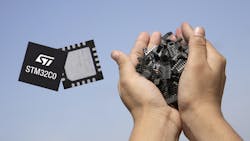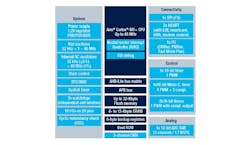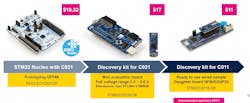Time to Migrate Away from 8- and 16-bit Micros?
What you’ll learn
- Why 8- and 16-bit micros might not be a good option for new applications.
- What where the advantages of 8- and 16-bit micros?
- Why new 32-bit micros are funneling into this space.
Developers have chosen small 8- and 16-bit micros since their inception and stuck with them as larger implementations were pushed out by 32-bit microcontrollers for higher-end applications. This was in part due to the larger address space, and partly due to the ease of programming using languages like C and C++. Those were applicable for 8- and 16-bit micros, but optimization could be more challenging with the older architectures.
Price also could be an issue since these were often very low-cost items. The availability of parts is another complication these days. The use of larger and older transistor technologies was an advantage in the past since vendors could utilize fabs longer. However, as newer fabs replace older ones, the advantage goes away. This isn’t to say that the older architecture chips are necessarily disappearing yet; rather, the newer, compact 32-bit solutions will be taking their place.
Such compact solutions can take advantage of the latest fabs and technologies. Also, the processor core no longer dominates the silicon footprint and designers can utilize the same peripherals used in existing, higher-end solutions. This also provides an almost trivial upgrade path to higher capacity and performance often lacking in 8- and 16-bit solutions.
New Low-Power MCU Family
STMicroelectronics is targeting the 8- and 16-bit space with its 32-bit STM32C0 family based on an Arm Cortex-M0+ (Fig. 1). The main differences between STM32C0 and its higher-end cousins is in power, speed, chip size, and memory, although the differences tend to be minor. The STM32C0 is designed to be very low power—it’s not a speed demon, but 48 MHz isn’t bad. The die and various chip layouts are compact and the amount of SRAM is from 6 to 12 kB with 32 kB of on-chip flash memory.
The family is designed to reduce the external options sometimes required by older 8- and 16-bit platforms, such as an external clock and multiple power supplies. Many newer 8- and 16-bit platforms also bring the clock inside the chip and use a single power supply, so don’t count out these platforms for this alone.
The chip requires a 2- to 3.6-V power supply, which is often the case for 8- and 16-bit parts, too. Some very old parts run off 5 V, but new designs will use lower voltages to reduce power requirements as well as make them compatible with newer peripheral chips. The dynamic power consumption of the STM32C0 is only 80 μA/MHz. Shutdown current is a mere 20 nA.
The system is supported by a plethora of free tools from STMicro, including the STM32 CubeIDE and STM32 CubeMonitor as well as third-party tools like the Eclipse IDE, Arm Keil, and IAR Systems. The chip works with platforms such as the Azure RTOS. A number of kits are available that support expansion and carrier board platforms like Arduino and QFN20/DIP20 (Fig. 2).
So, if you have an 8- or 16-bit design that was in an 8- to 48-pin package or other small form factor, then the SRM32C0 might be a candidate for your next design.
About the Author
William G. Wong
Senior Content Director - Electronic Design and Microwaves & RF
I am Editor of Electronic Design focusing on embedded, software, and systems. As Senior Content Director, I also manage Microwaves & RF and I work with a great team of editors to provide engineers, programmers, developers and technical managers with interesting and useful articles and videos on a regular basis. Check out our free newsletters to see the latest content.
You can send press releases for new products for possible coverage on the website. I am also interested in receiving contributed articles for publishing on our website. Use our template and send to me along with a signed release form.
Check out my blog, AltEmbedded on Electronic Design, as well as his latest articles on this site that are listed below.
You can visit my social media via these links:
- AltEmbedded on Electronic Design
- Bill Wong on Facebook
- @AltEmbedded on Twitter
- Bill Wong on LinkedIn
I earned a Bachelor of Electrical Engineering at the Georgia Institute of Technology and a Masters in Computer Science from Rutgers University. I still do a bit of programming using everything from C and C++ to Rust and Ada/SPARK. I do a bit of PHP programming for Drupal websites. I have posted a few Drupal modules.
I still get a hand on software and electronic hardware. Some of this can be found on our Kit Close-Up video series. You can also see me on many of our TechXchange Talk videos. I am interested in a range of projects from robotics to artificial intelligence.



